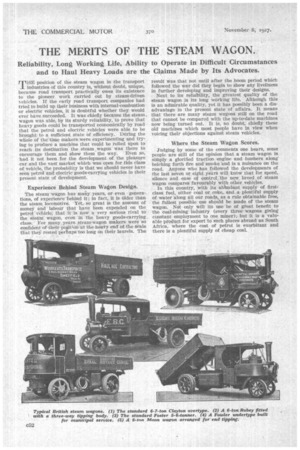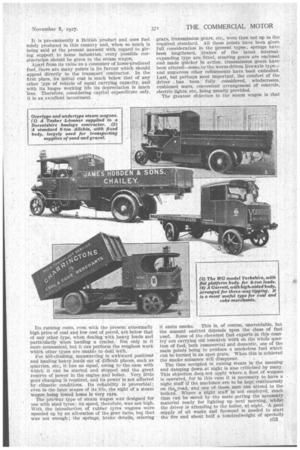THE MERITS OF THE STEAM WAGON.
Page 110

Page 111

Page 112

If you've noticed an error in this article please click here to report it so we can fix it.
Reliability, Long Working Life, Ability to Operate in Difficult Circumstances and to Haul Heavy Loads are the Claims Made by Its Advocates.
T"Eposition of the steam wagon in the transport industries of this country is, without doubt, unique, because road transport practically owes its existence to the pioneer work carried out by steam-driven ehieles. If the early road transport companies had tried to build up their business with internal-combustion or electric vehicles, it is doubtful whether they would ever have succeeded. It was chiefly because the steam. wagon was able, by its sturdy reliability, to prove that heavy goods could be transported ecimomically by road that the petrol and electric vehicles were able to be brought to a sufficient state of efficiency. During the whole of the time makers were experimenting and trying to produce a machine that conld be relied upon to reach.. its destination the steam wagon was there to encourage them and show them the way. Even so, had it not been for the development, of. the pleasure car and the vast market which was open for this class of vehicle, the probability is that we should never have seen petrol and electric goods-carrying vehicles in their present state of development.
Experience Behind Steam Wagon Design.
The steam wagon has may years, or even generations, of experience &hind it; in fact, it is older than the steam locomotive. Yet, so great is the amount of money and labour that have been expended on the petrol ' Vehicle; that it -is now avery serious rival to the Steam wagon, even 'in the heavy goods-carrying class. For .many years steam-wagon makers were so confident of their position at the heavy end of.the scale that the rested perhaps too long on their laurels. The
result was that not until after the boom period which followed the war did they begin to show any liveliness in further developing and improving their designs.
Next to its reliability, the greatest quality of the steam wagon is its long working life. Although this is an admirable quality, yet it has possibly been a disadvantage in the present state of affairs. It means that there are many steam wagons still on the road that cannot be compared with the up-to-date machines now being turned out. It is, no doubt, chiefly these old machines which most people have in view when voicing their objections against steam vehicles.
Where the Steam Wagon Scores.
Judging by some of the comments one hears, some people are still of the opinion that a steam wagon is simply a glorified traction engine and lumbers along belching forth fire and smoke and is a nuisance on the road. Anyone who has followed the developments of the last seven or eight years Will-know that for speed, silence and ease of control,. the new breed of steam wagon compares favourably with other vehicles. In this country, With its ablindant supply of firstclass fuel, either coal or cote, and a plentiful supply of water along all our roads, as a rule obtainable free, the fullest possible use should be made of the steam wagon. Not only Will its use be of great benefit to the coal-inining industry (every three wagons giving constant employment to one miner), but it is a valuable product for export to such places abroad as South Africa, where the cost of petrol is exorbitant and there is a plentiful supply of cheap coal.
It is pre-eminently a British product and uses fuel solely produced in this country and, when so much is being said at the present moment With regard to giving support to home industries, every possible consideration.should be given to the steam wagon.
Apart from its value as a consumer of home-produced fuel, there are many points in its favour which should appeal directly to the transport' contractor. In the first place, its initial cost is much below. that of any other type of vehicle of equal carrying capacity, and: with its longer working life its depreciation is much less. Therefore, considering capital expenditure only, it is an excellent investment.
Its running costs, even with the present abnormally high price of coal and low cost of petrol; are below that of any other type, when dealing with heavy loads and particularly when hauling a trailer.' Not only is. it more economical, but it can perform the roughest work which other types are unable to deal With.
For hill-climbing, manceuvring in awkward position and hauling heavy loads out of difficult praces, Such as quarries, etc., it has no equal owing to. the ease with which it can be started and shipped and the great reserve of power in the engine and boiler. .Irery little gear changing is required, and its power is not affected by climatic conditions. Its reliability is proverbial ; even in the later stages of its life.. the sight of a steam wagon being towedhome is very rare.
The pre-war type of steam wagon was designed for use with steel tyres; its speed, therefore, was not high. With the introduction of rubber tyres wagons were speeded up by an alteration of the gear ratio, but that was not enough ; the springs, brake • details, steering
gears, transmission gears, etc., were then not up to the required standard. All these points have been given full consideration in the present types; springs have been lengthened, brakes of the latest internalexpanding type are fitted, steering gears are enclosed and made quicker in action, transmission gears have been altered—sonic to the worm-driven live-axle type— and numerous other refinements. have been embodied. Last, but perhaps most important, the comfort of the driver has been fully considered, windscreens,' cushioned seats, convenient arrangement of controls, electric lights, etc., being usually provided.
The greatest objection to the steam wagon is that it emits smoke. This is, of course, unavoidable, but the amount emitted depends upon the class of fuel used. Some of the cleverest fuel experts in this country are carrying out research work oh the whole question of fuel, both commercial and domestic, one of the main points being to produce a smokeless fuel which can be burned in an open grate. 'When this is achieved the Smoke nuisance will disappear. .
The time occupied in raising steam in the morning and damping down at night is also criticised by many. This objection does not apply. where ..a fleet of wagons is operated, for in this case it is necessary to have a night staff if the machines are to be kept continuously on theo road, and one of these:mert can attend to the boilers. Where a night staff is not employed, much time can be saved by the mate getting the necessary material ready for lighting up next morning, whilst the driver is attending to the boiler, at night. A good supply of oil waste and firewood is needed to start the fire and about half a hundredweight of specially
picked coal, free from dirt, will soon give a good fire and full steam pressure.
A quick way of lighting up is to have a good fire handy with plenty of fuel in an incandescent state, and to use this for starting the fire in the boiler. This is a great advantage if coke is being used, as it is slower to get going; if no fire be handy when coke is the fuel, coal should be used to light up.
When wagons are fitted with a blower valve, this can be used when the pressure has reached 30 lb. If the wagon be of the free-engine type it is advantageous to start the engine; this will warm up the engine as well as blow up the fire,
A Useful Time-saving Method.
Another method of saving time is to damp down the fire overnight. To do this, after filling up the boiler well above the gauge glass, the fire must be clinkered and the firebox well filled up with fuel. Then the firedoor, damper and top of funnel must be closed to prevent any through draught and the water-gauge cocks be shut off as a precaution against possible breakage of the glass. The boiler will then be hot next morning and showing about 10 lb. of steam_ The fire must then be cleaned out and relit and full steam will be raised in about 20 to 30 minutes.
The extra coal used by this method will cost about one shilling, but the time saved will be about half an hour. As the earning capacity of a wagon is at least ten shillings per hour. the 'gain is five times the expenditure.
A Setback for the Industry.
The steam-wagon industry received a very serious setback hist year owing to the unfortunate dispute in the coal-mining industry, but it would be very disastrous in many ways if this be made an excuse for ignoring the claims of British steam wagons. It must always be borne in mind that there is not that certainty regarding the continuance of petrol supplies That there is with coal. In this country there is known to exist sufficient coal to last for 700 years at the present rate of consumption. Can anyone say with certainty what the position will be with regard to supplies of .petrol even as short a period as seven years hence? Steam wagons have also been handicapped by the great increase this year in the licence duties. This is a question which merits special consideration in view of the undoubted benefits to the coal-mining industry and to our export trade by the continuance or the steam-wagon industry.




















































































































































































